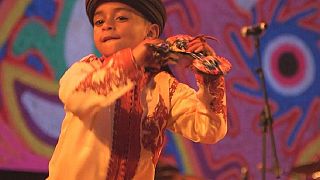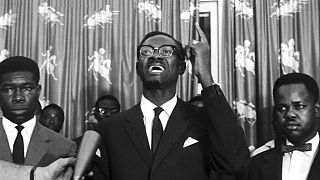Morocco
In Morocco, young women are reclaiming the centuries old art of Gnaoua by bringing a new and inclusive energy to the spiritual musical repertoire that gained worldwide popularity after it was listed by UNESCO as intangible culture heritage in 2019.
"Tagnaouite has gained worldwide recognition with its UNESCO listing. Why shouldn't a woman play the guembri? Why shouldn't women be part of this dynamic? Women were at best simple members of Gnaoua groups, but never leaders. And the day I had the opportunity to play the guembri and succeeded in playing this instrument, I didn't hesitate for a second," shared Asma Hamzaoui, frontwoman of the all-female "Bnat Timbouktou".
The 26-year-old Casablanca native is one of the first women to perform Gnaoua, which blends African rhythms with spiritual chants and poetry.
Her father, a Gnaoua master, initiated her into the art form at a young age.
"I've accompanied him to his evening gatherings since I was seven years old," recounted the young woman, who in 2012 formed the group "Bnat Timbouktou", or The Girls of Timbuktu.
"I gradually learned to play the guembri, a three-stringed lute made of camel skin. My father made sure that I learned as much as possible before I flew solo."
The all-female ensemble wowed the festival-goers -- with Hamzaoui on vocals and the guembri, and four musicians on qraqeb steel castanets.
They played alongside the Amazones d'Afrique, another all-female group, from Mali.
This young woman’s ambition empowered many others such as Hind Ennaira to explore their passion for the traditionally masculine art form, which blends African rhythms with spiritual chants and poetry.
Gnanoua is also an ensemble that goes beyond just music, it also impacts clothes.
Feeds the spirit
"I started in 2016 and the idea of putting a group together was born in 2018. I put together a traditional ensemble made up of men with myself alone as the female leader, I tried to change the concept (of all-male Gnaoua groups)."
Originally practised by enslaved people and dating back at least to the 16th century, Gnaoua has gone from being practised largely in private gatherings, where therapeutic rituals accompanied the music, to public events such as concerts and festivals.
The Gnaoua festival held every summer in Essaouira has been promoting Gnaoua culture worldwide since 1997.
Jimi Hendrix Style
Yousra Mansour, the frontwoman of the band Bab L'bluz ("The Blues Gate"), which fuses Gnaoua, rock and blues, also encountered challenges entering the music scene.
"There were two constraints for me: first, the fact that this field is usually reserved for men, but also how we interpret traditional music," explained the musician.
"It is not very accepted or even tolerated by some of the stricter individuals.
"We replaced the bass with the guembri and the guitar with the awisha (a small guembri) and created a kind of 'power trio' in the style of Jimi Hendrix with reimagined traditional instruments," explained Mansour.
The 32-year-old vocalist passionately defends women's freedoms, saying that "as a woman, I have not had an easy life".
"There was a lack of women in this field. When I see Asma Hamzaoui or Hind Ennaira, they are magnificent," she said.
"It is not easy to evolve in a predominantly male universe, but we see changes emerging."











02:19
From tattoos to bark cloths, Samoa keeps proud traditions alive
00:59
Cher releases first part of 'intimate' memoir, detailling her meteoric rise to fame
01:07
Yale University to offer course on Beyoncé next year
01:00
Record number mariachis belt out classic songs in Mexico City plaza
01:09
South Africa's Tyla wins big at MTV EMAs
01:00
Juliette Binoche launches Paris Christmas window display